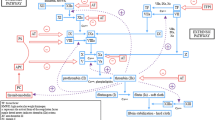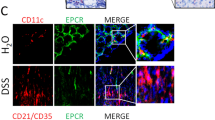Abstract
Chronic inflammation is associated with increased erythrocyte adhesiveness/aggregation. This might have deleterious effects on the microcirculatory flow and tissue oxygenation. We aimed to determine the degree of erythrocyte adhesiveness/aggregation in the peripheral blood of individuals with inflammatory bowel disease (IBD). Fifty-two patients (24 women and 28 men) with ulcerative colitis (UC) at a mean age of 44.0 ± 16.8 years and 96 patients (44 women and 52 men) with Crohn’s disease (CD) at a mean age of 38.0 ± 15.5 years, with various degrees of disease activity, were matched to normal controls. A simple slide test and image analysis were used to determine the degree of erythrocyte adhesiveness/aggregation. CD activity index (CDAI) was determined in patients with CD, while clinical colitis activity index was applied for patients with UC. A significant (P < 0.0005) increment in the degree of erythrocyte adhesiveness/aggregation was noted in both groups of IBD patients compared with matched control groups. This increment was evident even in individuals with a low index of disease activity and during remission. The highly significant correlation with the concentrations of fibrinogen suggests that the degree of erythrocyte adhesiveness/aggregation is an inflammation-related phenomenon. An enhanced state of erythrocyte adhesiveness/aggregation was noted in the peripheral blood of patients with IBD. This might have a deleterious effect on intestinal microcirculatory flow and tissue oxygenation.
Similar content being viewed by others
References
Soutani M, Suzuki Y, Tateishi N, et al.: Quantitative evaluation of flow dynamics of erythrocytes in microvessels: influence of erythrocyte aggregation. Am J Physiol 268:H1959–H1965, 1995
Schmid-Schonbein H: Blood rheology and physiology of microcirculation. Ric Clin Lab 11(Suppl 1):13–33, 1981
Bishop JJ, Nance PR, Popel AS, et al.: Effect of erythrocyte aggregation on velocity profiles in venules. Am J Physiol Heart Circ Physiol 280:H222–H236, 2001
Mchedlishvili G, Gobejishvili L, Mamaladze A, et al.: Microcirculatory stasis induced by hemorheological disorders: further evidence. Microcirculation 6:97–106, 1999
Cabel M, Meiselman HJ, Popel AS, et al.: Contribution of red blood cell aggregation to venous vascular resistance in skeletal muscle. Am J Physiol 272:H1020–H1032, 1997
Mchedlishvili G, Varazashvili M, Gobejishvili L: Local RBC aggregation disturbing blood fluidity and causing stasis in microvessels. Clin Hemorheol Microcirc 26:99–106, 2002
Tateishi N, Suzuki Y, Cicha I, et al.: O2 release from erythrocytes flowing in a narrow O2-permeable tube: effects of erythrocyte aggregation. Am J Physiol Heart Circ Physiol 281:H448–H456, 2001
Tateishi N, Suzuki Y, Shirai M, et al.: Reduced oxygen release from erythrocytes by the acceleration-induced flow shift, observed in an oxygen-permeable narrow tube. J Biomech 35:1241–1251, 2002
Novacek G, Vogelsang H, Genser D, et al.: Changes in blood rheology caused by Crohn’s disease. Eur J Gastroenterol Hepatol 8:1089–1093, 1996
Best WR, Becktel JM, Singleton JW, et al.: Development of a Crohn’s disease activity index. National Cooperative Crohn’s Disease Study. Gastroenterology 70:439–444, 1976
Walmsley RS, Ayres RC, Pounder RE, et al.: A simple clinical colitis activity index. Gut 43:29–32, 1998
Cohen S, Tolshinsky T, Rogowski O, et al.: Real time, control adjusted evaluation of intensity of the inflammatory response. J Inform Techn Healthcare 1:195–207, 2003
Fusman G, Mardi T, Justo D, et al.: Red blood cell adhesiveness/aggregation, C-reactive protein, fibrinogen and erythrocyte sedimentation rate in healthy adults and in those with atherosclerotic risk factors. Am J Cardiol 90:561–563, 2002
Rotstein R, Landau T, Twig A, et al.: The erythrocyte adhesiveness/aggregation test (EAAT). A new biomarker to reveal the low grade subclinical smoldering inflammation individuals with atherosclerotic risk factors. Atherosclerosis 165:343–351, 2002
Rotstein R, Fusman R, Zeltser D, et al.: The picture of inflammation: a new concept that combines the white blood cell count and erythrocyte sedimentation rate into a new hematologic diagnostic modality. Acta Haematol 106:106–114, 2001
Sharshun Y, Brill S, Mardi T, et al.: Inflammation at a glance: erythrocyte adhesiveness/aggregation to reveal the presence of inflammation in individuals with atherothrombosis. Heart Dis 5:182–183, 2003
International Committee for Standardization in Hematology: Recommendation of measurement of erythrocyte sedimentation rate of human blood. Immunochemistry 2:235–254, 1965
Clauss A: Gerinnungsphysiologische Schnellmethode zur Bestimmung des Fibrinogens. Acta Haematol Basel 17:237–246, 1957
Rifai N, Tracy RP, Ridker PM: Clinical efficacy of an automated high-sensitivity C-reactive protein assay. Clin Chem 45:2136–2141, 1999
Ben Ami R, Barshtein G, Zeltser D, et al.: Parameters of red blood cell aggregation as correlates of the inflammatory state. Am J Physiol Heart Circ Physiol 280:H1982–H1988, 2001
Ben Ami R, Barshtein G, Mardi T, et al.: A synergistic effect of albumin and fibrinogen on immunoglobulin-induced red blood cell aggregation. Am J Physiol Heart Circ Physiol 285:H2663–H2669, 2003
Fabry TL: Mechanism of erythrocyte aggregation and sedimentation. Blood 70:1572–1576, 1987
Imaizumi K, Shiga T: Effect of immunoglobulins and IgG-fragments on the human erythrocyte aggregation, studied by rheoscope combined with image analyzer. Biorheology 20:569–577, 1983
Weng X, Cloutier G, Beaulieu R, et al.: Influence of acute-phase proteins on erythrocyte aggregation. Am J Physiol 271:H2346–H2352, 1996
Weng X, Roederer GO, Beaulieu R, et al.: Contribution of acute-phase proteins and cardiovascular risk factors to erythrocyte aggregation in normolipidemic and hyperlipidemic individuals. Thromb Haemost 80:903–908, 1998
Schechner V, Shapira I, Berliner S, et al.: Significant dominance of fibrinogen over immunoglobulins, C-reactive protein, cholesterol and triglycerides in maintaining increased red blood cell adhesiveness/aggregation: A model in hypercholaesterolemic patients. Eur J Clin Invest 33:955–961, 2003
Pepys MB, Hirschfield GM: C-reactive protein: a critical update. J Clin Invest 111:1805–1812, 2003
Maresca G, Di Blasio A, Marchioli R, et al.: Measuring plasma fibrinogen to predict stroke and myocardial infarction: an update. Arterioscler Thromb Vasc Biol 19:1368–1377, 1999
Barron HV, Cannon CP, Murphy SA, et al.: Association between white blood cell count, epicardial blood flow, myocardial perfusion, and clinical outcomes in the setting of acute myocardial infarction. A thrombolysis in myocardial infarction 10 substudy. Circulation 102:2329–2334, 2000
Ballou SP, Lozanski G: Induction of inflammatory cytokine release from cultured human monocytes by C-reactive protein. Cytokine 4:361–368, 1992
Cermak J, Key NS, Bach RR, et al.: C-reactive protein induces human peripheral blood monocytes to synthesis tissue factor. Thromb Haemost 84:730–731, 2000
Torzewski M, Rist C, Mortensen RF, et al.: C-reactive protein in the arterial intima: role of C-reactive protein receptor-dependent monocyte recruitment in atherogenesis. Arterioscler Thromb Vasc Biol 20:2094–2099, 2000
Labarrere CA, Lee JB, Nelson DR, et al.: C-reactive protein, arterial endothelial activation, and development of transplant coronary artery disease: a prospective study. Lancet 360:1462–1467, 2002
Danenberg HD, Szalai AJ, Swaminathan RV, et al.: Increased thrombosis after arterial injury in human C-reactive protein-transgenic mice. Circulation 108:512–515, 2003
Kobayashi S, Inoue N, Ohashi Y, et al.: Interaction of oxidative stress and inflammatory response in coronary plaque instability: important role of C-reactive protein. Arterioscler Thromb Vasc Biol 23:1398–1404, 2003
Klingel R, Fassbender C, Fassbender T, et al.: Rheopheresis: rheologic, functional and structural aspects. Ther Apher 4:348–357, 2000
Hadengue A, Razavian SM, Del-Pino M, et al.: Influence of sialic acid on erythrocyte aggregation in hypercholesterolemia. Thromb Haemost 76:944–949, 1996
Cicha I, Suzuki Y, Tateishi N, et al.: Enhancement of red blood cell aggregation by plasma triglycerides. Clin Hemorheol Microcirc 24:247–255, 2001
Rotstein R, Zeltser D, Shapira I, et al.: An inflammation meter to reveal the presence and extent of inflammation in older patients. J Am Gerontol Soc 48:1739–1741, 2000
Rotstein R, Zeltser D, Shapira I, et al.: The usefulness of an inflammation meter to detect the presence of infection/inflammation in elderly patients. J Gerontol A Biol Sci Med Sci 57:M122–M127, 2002
Rogowski O, Zeltser D, Rotstein R, et al.: Correlated expression of adhesive properties for both white and red blood cells during inflammation. Biorheology 37:361–370, 2000
Gamzu R, Rotstein R, Fusman R, et al.: Increased erythrocyte adhesiveness and aggregation in peripheral venous blood of women with pregnancy-induced hypertension. Obstet Gynecol 98:307–312, 2001
Lominadze D, Dean WL: Involvement of fibrinogen specific binding in erythrocyte aggregation. FEBS Lett 517:41–44, 2002
Author information
Authors and Affiliations
Corresponding author
Rights and permissions
About this article
Cite this article
Zilberman, L., Rogowski, O., Rozenblat, M. et al. Inflammation-Related Erythrocyte Aggregation in Patients with Inflammatory Bowel Disease. Dig Dis Sci 50, 677–683 (2005). https://doi.org/10.1007/s10620-005-2556-2
Received:
Accepted:
Issue Date:
DOI: https://doi.org/10.1007/s10620-005-2556-2




